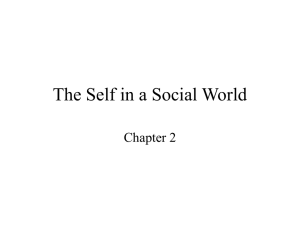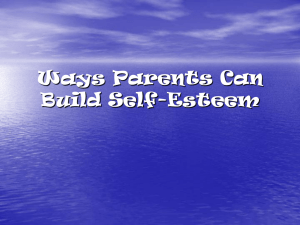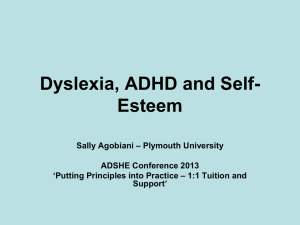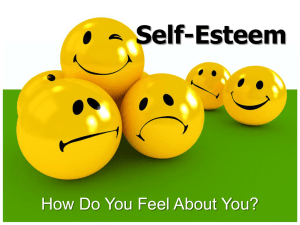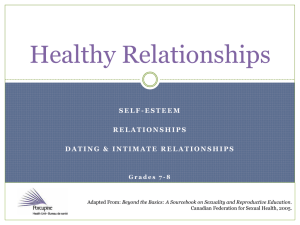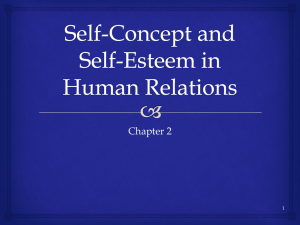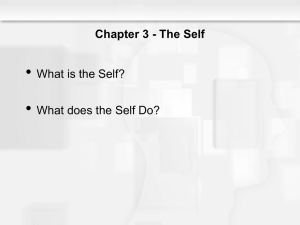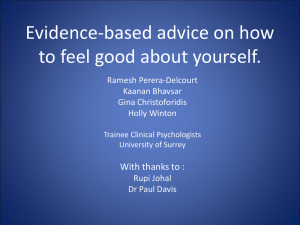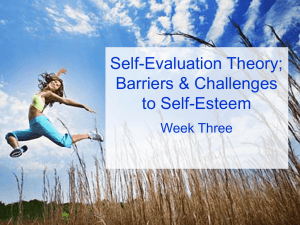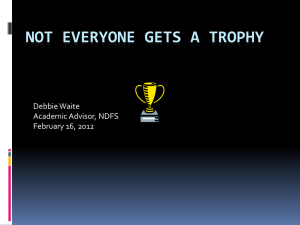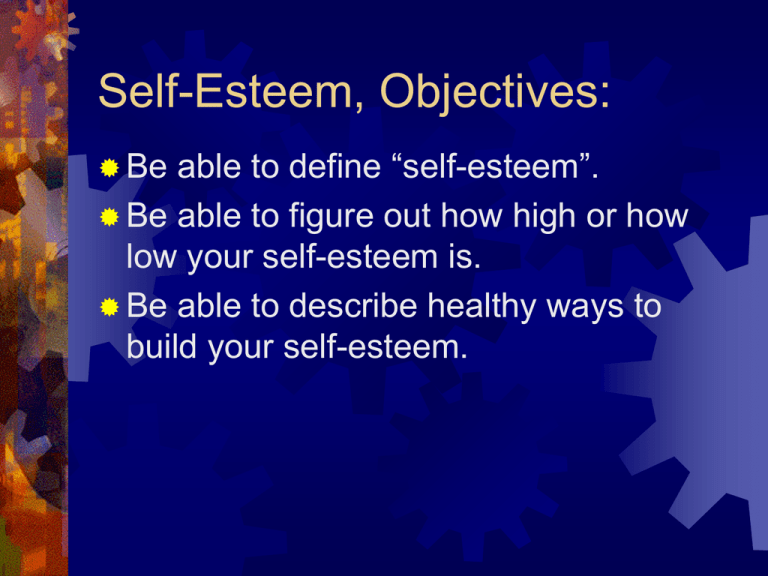
Self-Esteem, Objectives:
Be
able to define “self-esteem”.
Be able to figure out how high or how
low your self-esteem is.
Be able to describe healthy ways to
build your self-esteem.
What is self esteem ?
Self-worth
Confidence
in our ability to think and
cope with life’s challenges
Confidence in our right to be happy and
successful
A feeling that we are deserving, entitled
to assert our needs and desires
Benefits of high self-esteem
More
persistent at a difficult task
Increased respect for oneself and
behave in ways that encourage others
to respect (Me)more
Improve unconscious behavior
Feel better, live better
The impact of self-esteem on
our lives:
How
we operate in the workplace
School
Home
How we chose our friends
Who we fall in love with
The higher our self-esteem
The easier we are able to pick ourselves up
after a fall (tragedies,problems etc.).
The stronger the drive to express our true
nature and the sense of richness within.
The better we are able to form nurturing vs.
toxic relationships.
The tendency to be drawn to others with high
self-esteem.
Our first steps to building selfesteem is to:
•
•
•
Raise the level of our consciousness in
the face of emotional resistance.
Claim our personal power.
Identify “pseudo-self-esteem”: someone
that has a lot of worldly success but
feels like a failure inside and has a deep
sense of inadequacy.
Healthy vs. unhealthy
self-esteem
Rationality, realism
Creativity
Independence
Flexibility
Ability to manage
change
Willingness to admit
mistakes
See others as
inferior
Fear of the unknown
Inappropriate
conformity or
rebelliousness
Defensiveness
Over controlling
hostility
High self-esteem
Is
the best predictor of personal
happiness.
Is like having an emotional surplus, thus
it is easier to love.
The opposite is emotional
improvishment, which means you have
a lot of unfulfilled needs.
Maslow’s hierarchy of needs
Draw
a triangle
On the bottom put your basic human
needs, food, oxygen, water, sex
Next put shelter, safety, health
Then love and belonging
Then education, learning, self-esteem
At the top:self-actualization
A self-actualized person displays:
Acceptance
of self, others and nature
Self-direction, highly motivated
Problem-solving ability
Satisfying relationship with others
The needs are simple, but for
many of us, we do not feel
truly deserving of the higher
level needs
What is required for many of us,
paradoxical though it may sound,
is the courage to tolerate
happiness without self-sabotage
Within ourselves we have:
Destructive
voices
Memories, unconscious and conscious
of failure
Fear
Self-doubt
Self-sabotage
Confronting those voices
Try
not to run from them
Try not to ignore them
Challenge them to give reasons
Distinguish between fact and fiction,
Distinguish between feelings that are
based on reality vs a non reality
perseverance is self-esteem building
Average self-esteem:
Fluctuate
between feeling appropriate
and inappropriate
Sometimes act wisely, sometimes
foolishly
Inconsistent in behavior
This relationship with self reflects
relationships with others
What causes low self-esteem?
Overly
critical Parents
Significant childhood losses
Parental abuse
Parental alcoholism and drug addiction
Parental neglect/overprotectiveness
Parental rejection
Parental overindulgence
How can we improve our selfesteem?
Living
more consciously
Taking good care of yourself
The practice of self-acceptance
The practice of self-responsibility
Self assertiveness
Developing support and intimacy
The practice of personal integrity
The practice of living
consciously:
Watch
your thoughts…do you find
yourself saying:
I know I am not doing my best but I do
not want to think about it.
I know the way I eat is wrecking my
health but….
I know I am living beyond my means,
but…
Living consciously means:
Being
in the moment
A concern to understand the world
around me
A commitment to learning
To seek clarity
Be aware of values that motivate me
Distinguish between facts and feelings
Self acceptance
Self-esteem
is something we
experience, self-acceptance is
something we do.
Refusal to be in an adversarial
relationship with self.
Listening to feelings can lead to a
deeper awareness of important
information
Selfassertiveness/responsibility
Willingness
to stand up for self
Protecting boundaries
To live by your values
Learn to be kind without self-sacrificing
Cooperate with others without betraying
our standards and convictions
Living purposefully
To
live productively
Translating thoughts into reality
Answering questions such as: What am
I trying to achieve ? Why do I think
these means are appropriate ? Does
the feedback from the environment
convey that I am succeeding or failing ?
The practice of personal
integrity
Is
the integration of ideals, standards,
beliefs and behaviors
When our behavior is congruent with
our professed values, when ideals and
practice match, we have integrity
When we have lapses in integrity it is
detrimental to our self-esteem
One of the biggest enemies to
high self-esteem is Laziness:
We
do not challenge our inertia
We do not chose to be “awake”
We do not wish to experience
discomfort
The greatest problem is that it becomes
a vicious cycle and our “laziness” or
inaction damages our self-esteem and
we tend to become more lazy.
Self-esteem exercise
If
I bring more awareness to my life
today…..
If I boost my energy level by 5%
today…
Write a letter to your “inner child”:
Start by taking a few deep breaths, picture yourself
as a child,ask yourself are there any needs that were
not met, then write a nurturing letter to sooth your
“inner child”.

